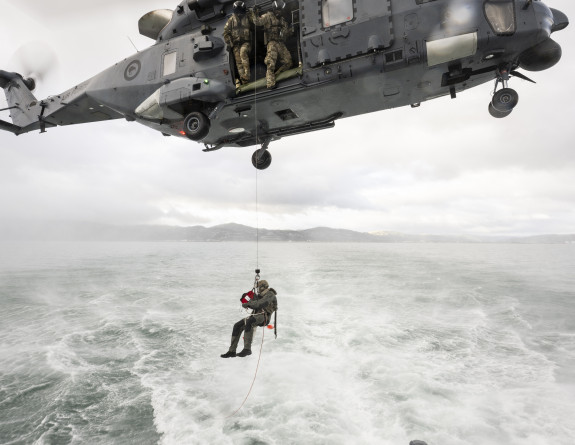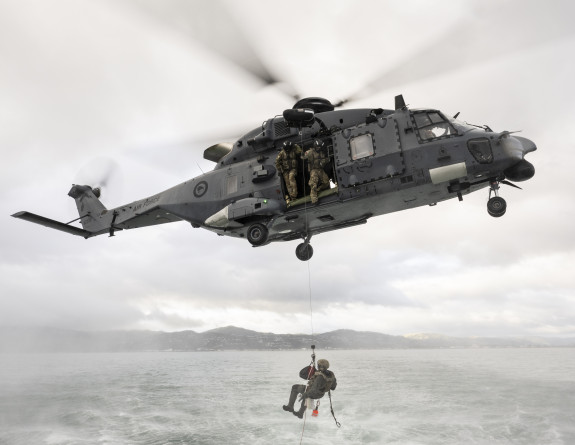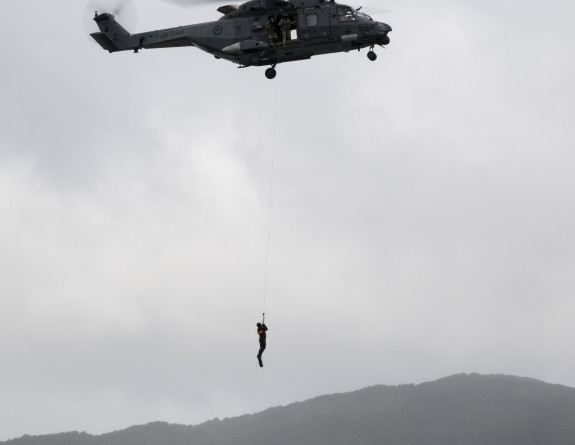
New Zealand-led task force makes $NZ332-million drug bust in the Middle East
14 March 2025
Unfortunately you are viewing this website on an outdated browser which does not support the necessary features for us to provide an adequate experience. Please switch to a modern browser such as latest version of Google Chrome, Mozilla Firefox, Apple Safari or Microsoft Edge.
Ngā mihi nui
A Royal New Zealand Air Force (RNZAF) NH90 helicopter hovers just a few metres above the New Zealand Police launch the Lady Elizabeth IV to winch Police divers into its airframe. The strong rotor downwash whips up the sea, drenching everyone on board.
The “wet and deck” training recently took place in Wellington’s harbour from the early evening to late into the night. The divers were plucked from the vessel as well as from the sea in a number of winching tasks to get helicopter crew qualified with the training.
The water temperature was a cool 14°C, which was not too bad according to the divers.
The crew need to be qualified in the work in order to support both military and search and rescue missions.
Sergeant Steve Kennedy from RNZAF Base Ohakea’s No. 3 Squadron said hovering so closely to the Police launch was challenging.
“We do a lot of training and talking about it before the flight, then it’s a coordination between the crew in the front and back seats in order to get us to the right angle, the right distance and getting the winch-person on and off the boat. It’s a large team effort to coordinate that successfully and safely.”



A diver is plucked from Lady Elizabeth IV by an NH90 helicopter during a winching task.
As day turns to night the procedure stays the same, but crew wear night vision goggles and use the helicopter’s powerful lights.
The weather was inclement, but SGT Kennedy said it was important to train in all conditions.
“A little bit of wind is helpful, it helps with the performance of the aircraft, but the downside is it can increase the swell, which moves the boat around a bit more, so we have to be a bit more on our game.
“People aren’t necessarily going to go missing in the water on calm sunny days. In real life you can’t always ask for what you want, so it gives us more of a chance to practise in rougher conditions.”
Working alongside other agencies like the police was always beneficial and they were always enthusiastic to take part in training opportunities, SGT Kennedy said.
Sergeant Baz Murfin from Police agreed and said working with the New Zealand Defence Force helped to enhance their skills if people needed to be plucked from the water or from a vessel in a medical evacuation scenario.
“It’s good to practise with different types of helicopters where the downwash will make the vessel act differently.”

An incident could happen at any time, and it was great to train at varying times.
“At night things change dramatically – you lose your perception of distance so it’s really good to train then so you can recognise limitations you have and then work from there.”
The police team enjoys its close relationship with No. 3 Squadron and have had opportunities to visit Base Ohakea, he said.
“We have been able to look at how they operate and have spoken with the crews. We now have a better appreciation of what they are dealing with and trying to achieve, from everyone down to what the person on the winch line wants as they come down to the deck.
“It’s a real win-win for us and we get a lot out of doing it with the Defence Force.”